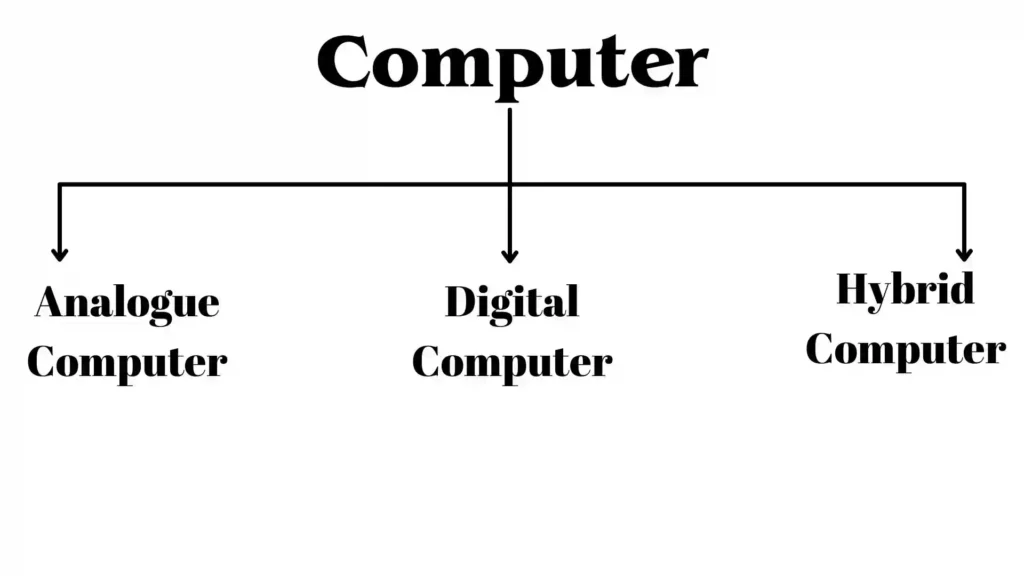Types of Computer
We can categorize computer in two ways: on the basis of data handling capabilities and size.
On the basis of data handling capabilities, the computer is of three types:
- Analogue Computer
- Digital Computer
- Hybrid Computer

Analogue Computer
Analogue computers are designed to process analogue data. Analogue data is continuous data that changes continuously and cannot have discrete values. We can say that analogue computers are used where we don’t need exact values always such as speed, temperature, pressure and current.
Analogue computers directly accept the data from the measuring device without first converting it into numbers and codes. They measure the continuous changes in physical quantity and generally render output as a reading on a dial or scale. Speedometer and mercury thermometer are examples of analogue computers.
Advantages of using analogue computers:
- It allows real-time operations and computation at the same time and continuous representation of all data within the rage of the analogue machine.
- In some applications, it allows performing calculations without taking the help of transducers for converting the inputs or outputs to digital electronic form and vice versa.
- The programmer can scale the problem for the dynamic range of the analogue computer. It provides insight into the problem and helps understand the errors and their effects.
Types of analogue computers:
- Slide Rules: It is one of the simplest types of mechanical analogue computers. It was developed to perform basic mathematical calculations. It is made of two rods. To perform the calculation, the hashed rod is slid to line up with the markings on another rod.
- Differential Analysers: It was developed to perform differential calculations. It performs integration using wheel-and-disc mechanisms to solve differential calculations.
- Castle Clock: It was invented by Al-Jarazi. It was able to save programming instructions. Its height was around 11 feet and it was provided with the display of time, the zodiac, and the solar and lunar orbits. This device also could allow users to set the length of the day as per the current season.
- Electronic Analogue Computer: In this type of analogue computer, electrical signals flow through capacitors and resistors to simulate physical phenomena. Here, the mechanical interaction of components does not take place. The voltage of the electrical signal generates the appropriate displays.
Image of Analogue Computer
Digital Computer
Digital computer is designed to perform calculations and logical operations at high speed. It accepts the raw data as input in the form of digits or binary numbers (0 and 1) and processes it with programs stored in its memory to produce the output. All modern computers like laptops, desktops including smartphones that we use at home or office are digital computers.
Advantages of digital computers:
- It allows you to store a large amount of information and to retrieve it easily whenever you need it.
- You can easily add new features to digital systems more easily.
- Different applications can be used in digital systems just by changing the program without making any changes in hardware
- The cost of hardware is less due to the advancement in the IC technology.
- It offers high speed as the data is processed digitally.
- It is highly reliable as it uses error correction codes.
- Reproducibility of results is higher as the output is not affected by noise, temperature, humidity, and other properties of its components.
Image Of Digital Computer
Hybrid Computer
Hybrid computer has features of both analogue and digital computer. It is fast like an analogue computer and has memory and accuracy like digital computers. It can process both continuous and discrete data. It accepts analogue signals and convert them into digital form before processing. So, it is widely used in specialized applications where both analogue and digital data is processed. For example, a processor is used in petrol pumps that converts the measurements of fuel flow into quantity and price. Similarly, they are used in airplanes, hospitals, and scientific applications.
Advantages of using hybrid computers:
- Its computing speed is very high due to the all-parallel configuration of the analogue subsystem.
- It produces precise and quick results that are more accurate and useful.
- It has the ability to solve and manage big equation in real-time.
- It helps in the on-line data processing.
Image of Hybrid Computer
FAQs on the Types of Computers
1. What are the Three Main Types of Computers?
On the basis of data handling capabilities, the three main types of computers are:
- Analog computers
- Digital computers
- Hybrid computers
2. What is a Workstation?
A workstation is a kind of computer that can be used for software development, desktop publishing, and creating engineering applications. Although a modest amount of processing power is present in a workstation, it has relatively good graphical capabilities.
3. What do you Understand by the Term Mainframe?
A mainframe is often very expensive and a very large type of computer. These kinds of computers have the potential to support hundreds and even thousands of people in one go. Furthermore, programs can run simultaneously, and concurrent execution is possible in mainframe computers.
4. What are the advantages of Analog computers?
The advantages of Analog computers are that it represents the data within the system’s range and enables users for real-time computations. These as well carry out the calculations without using transducers. Analog systems come in different types, such as Hybrid computers, Digital computers, Castlerock, Electronic Analog computers, slide rules, and differential analyzers. Each of these has advantages and drawbacks of its own. Students who need a thorough explanation of each can go through these on website.
5. What are slide rules?
The simplest analog computer system is the slide. It is used to carry out numerous mathematical computations. These are made up of two rods. The rod slides off with the marking on the other rod when there any calculations are made. In contrast, differential calculations are performed using differential analyzers. These operate using a wheel and disc system. Through Javatpoint, where correct explanations are given that are simple for all pupils to understand, they can learn all the concepts easily.
6. What are digital computers?
All logical operations are completed quickly and efficiently by digital computers. They work with digital or binary numbers. One of the numerous benefits of digital computers is that they can store a large amount of data. Digital computers can simply add new functionality. The cost of these computers is quite low, and the data processing is done at high speed. The cost is quite low, and the data processing is done quickly digitally. For further information about the different sorts of computers, students can consult Javatpoint.
7. What are mainframe computers?
The mainframe is a type of computer that can be characterized as an expensive and substantial computer system. This is very powerful as they have the potential to support numerous users at the same time. These also facilitate different program executions. It provides great performance with extensive memory management and has a long lifespan. Another advantage of using a mainframe is that errors are often quite infrequent, but when they do occur, the system automatically corrects them. They also have a wide range of applications.
8. What do you understand about Hybrid computers?
Digital and analog computers are combined in order to create hybrid computers. Although the accuracy and memory are close to digital computers, the speed is similar to analogue computers. Before the process, these kinds of computers take the analogue signals and transform them into digital signals. These are typically used in specialist applications that combine analog and digital data. Hybrid computers have the capability to resolve complicated problems in real-time and contain a very high speed.
9. Which type of computer has two or more processors and it supports 4 to 200 users at one time.
A minicomputer is a multiprocessing computer of medium size. This type of computer has two or more CPUs and can accommodate 4 to 200 users in one go.

